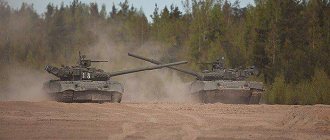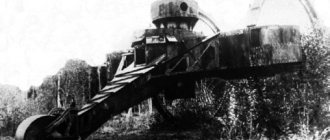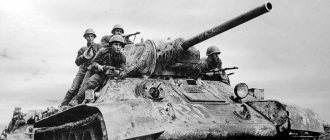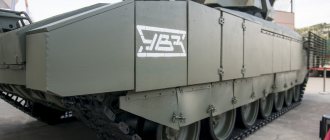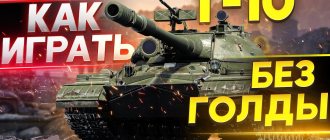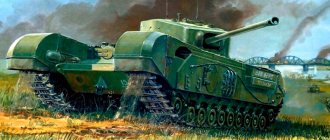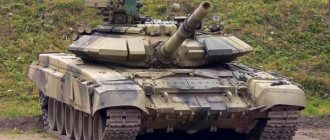As they say: “Tanks are not afraid of dirt.” This expression perfectly characterizes such a powerful machine as a tank. The tank is not afraid of any obstacles; you can not only feel completely safe in it, but also, in case of danger or enemy attack, defend yourself with the help of military artillery. It is a kind of multifunctional machine.
BM "Oplot"
Country: Ukraine Ukraine Years of activity: since 2009 Crew: 3 people. Combat weight: 51.0 t Engine power: 1200 hp Highway speed: 70 km/h Armor type: combined projectile
BM "Oplot" ("Oplot-M" before being put into service) is a modern Ukrainian main tank.
Developed by the Kharkov Mechanical Engineering Design Bureau named after. A.A. Morozov and manufactured by the ZTM plant named after. A.A. Malysheva. Chief designer of machine tools - Doctor of Technical Sciences, Prof., Lieutenant General. Borisyuk M.D., general designer for the creation of armored vehicles and artillery systems, head of the KMDB department.
As of 2016, Ukraine has 10 units in service, and Thailand has 15 units.
VII level
Su-100M1
- DPM - 2203 hp
- Armor penetration - 212 mm.
- Mixing time - 2.21 s.
- Spread - 0.39 m.
- Turret? - No
- Stationary camouflage% - 20.18 / 4.22
- Viewing range - 350 m.
- Range: 525 m.
Conclusion
- The Su-100 M1 is a very amazing tank destroyer.
- Penetrates most Tier X tanks and can reflect Tier IX shells.
- Thanks to the small silhouette, you can use your camouflage and fight your enemies. He can change position so quickly if necessary.
- Enemy penetration from the front could damage the engine in front and possibly cause an engine fire. Be careful when taking positions.
- Avoid higher level projectiles. Don't let your enemies get to you.
- You will undoubtedly give them hell.
T-90 "Vladimir"
Country: Russian Federation Russian Federation Years of activity: since 1992 Crew: 3 people. Combat weight: 46.5 t Engine power: 840 hp Highway speed: 60 km/h Armor type: combined projectile
T-90 is a Russian main tank. It was created in the late 80s - early 90s as a deep modernization of the T-72B tank under the name “Advanced T-72B”, but in 1992 it was put into service with the T-90 index. After the death of the main designer of the tank, Vladimir Ivanovich Potkin, by decision of the Russian government, the T-90 was named “Vladimirsky”.
The T-90 has a classic layout, with the control compartment located at the front, the fighting compartment in the center and the engine compartment at the rear. The T-90 crew consists of three people: a driver, located along the longitudinal axis of the tank in the control compartment, and a gunner and commander, located respectively in the turret to the left and right of the gun.
Uralvagonzavod keeps a certificate stating that the T-90 tank, model 1992, was at the disposal of one of the units in the conflict zone in Chechnya in the 1990s. Syrian T-90 tanks were used in battles near the city of Aleppo.
The best domestic tanks
At the Uralvagonzavod stand / Photo: Rostec
On the second Sunday of September, Russia traditionally celebrated Tank Driver Day - a professional holiday of tank crews and tank builders. for Uralvagonzavod . Today it is the only plant in Russia that develops and produces the best tanks in the world. Nowadays the modern Armata is being created here, and once upon a time the legendary T-34s rolled off the assembly line. For the holiday, we have made a selection of the most striking models of the country's tank fleet over the last century.
T-34: the legendary "thirty-four"
This famous vehicle became the most popular medium tank of World War II. In total, more than 65 thousand T-34 and its modifications have been produced in the world since 1940. Until the end of the war, Ural Tank Plant No. 183, which would later become Uralvagonzavod, produced more than 25 thousand T-34s. That is, every second tank that fought was made at this plant.
The T-34 tank actually began the domestic design school of tank building, which took shape at UVZ. The plant's design bureau was responsible for modernizing the tank. The T-34 was superior to enemy tanks in many characteristics, especially maneuverability and maneuverability. However, by 1943, with the advent of new equipment with more powerful guns, the need arose to modify it.
Column of T-34-85 tanks of the 2nd Far Eastern Front
Ural designers developed the T-34-85 model with an 85 mm cannon, for which the turret was also redesigned. Having retained all the advantages of the base model, the new tank in its power could now compete with German tanks equipped with 75 mm caliber guns. It is the T-34-85 that can be called the weapon of Victory in the Great Patriotic War. In the USSR it was produced until the end of the war, and in the 1950s it continued to be manufactured under license in Poland and Czechoslovakia. It is interesting that until recently the T-34-85 was still in service in some countries.
T-44: to replace the Victory tank
The development of the new T-44, which was supposed to replace the T-34 at the front, took place in 1943-1944. The creation of the tank at UVZ was carried out by chief designer Alexander Morozov, one of the authors of the T-34. Perhaps that is why both tanks are similar in appearance. But structurally these are completely different machines.
T-44 tank crosses a water barrier
The main task of the designers in creating the T-44 was to increase armor protection. In parallel with this, other changes were made. The diesel engine was placed across the vehicle, which made it possible to reduce the length of the hull, reduce the overall weight and improve the driving performance of the tank. The turret was changed, the fighting compartment was increased, and conditions for the crew were improved. Despite the fact that the T-44 was mass-produced, it failed to fully replace the T-34, since already in 1947 a more advanced model, the T-54, was developed.
T-54/55: Kalashnikovs among tanks
During the war, extensive experience was gained in the use of armored vehicles, which needed to be put into practice. The T-54 tank became the first serial post-war tank in the USSR. The history of the T-54 is inseparable from the history of the T-44, since both of these vehicles were developed to replace the T-34-85. Many developments from the T-44 were used in the T-54 and T-55.
After a series of experiments with a 100-mm gun, which was supposed to replace the outdated 85-mm, in the fall of 1944 the project for a new tank called the T-54 was approved for implementation. The tank was mass-produced from 1947 to 1958, constantly being modified. In terms of combat qualities, it surpassed all known medium tanks. In addition to the USSR, the T-54 was produced in China, Korea, Czechoslovakia and Poland with a total of 20,375 tanks.
Tank T-54
Since 1958, the T-55 modification has been produced. This is the world's first production tank designed to conduct combat operations under conditions of the use of nuclear weapons. It also became the first tank on which, during a major modernization in the 1980s, an active protection complex was installed, which destroyed or weakened the effect of an enemy combat projectile. Serially produced in Poland, Romania and Czechoslovakia. A total of 23,600 vehicles were produced.
T-54 and T-55 were widely used throughout the world and participated in most local conflicts of the second half of the 20th century. Due to their simplicity and high reliability, they are still in service in many countries.
T-62: the first with a smoothbore gun
The next tank created by UVZ designers was the T-62 - the world's first production tank with a smoothbore gun. It was intended to replace the T-54/55 model, since despite constant updates to the tank, its 100 mm gun could no longer withstand the competition. The shells of the new T-62 smoothbore gun had greater penetrating power.
Tank T-62
The tank was equipped with radiation protection and an automatic fire extinguishing system. T-62s were produced in the USSR until 1975, as well as in Czechoslovakia and China. In total, about 20,000 vehicles of various modifications were produced. The T-62 performed well in combat in Afghanistan, resulting in increased global demand for it. This reliable and unpretentious tank is still used today in the tank armies of some countries.
T-72: from the Urals around the world
Fire, armor and maneuver are embodied in the most popular tank of our time, the T-72 Ural, which forms the basis of the ground forces of dozens of countries. T-72 belongs to the second generation of tanks. Developed in the late 1960s and early 1970s under the leadership of the chief designer of the Uralvagonzavod Design Bureau V.N. Venediktova. Adopted into service in 1973 and produced in quantities of more than 30 thousand. In addition to the Eastern Bloc countries, it was produced under license in India and Iran. For its creation and organization of production, Uralvagonzavod was awarded the Orders of Lenin and the October Revolution.
Tank T-72
The T-72 tank has participated in all armed conflicts in recent years, right up to the events in Ukraine and the Syrian Republic. Modifications of the tank are still being carried out at UVZ. The T-72B3 model is equipped with Kontakt-5 and Relikt explosive reactive armor protection, as well as a 2A46M-5-01 cannon, which makes this tank as close as possible to third-generation vehicles of the T90A type.
T-90 "Vladimir": an international hit
The third generation T-90 Vladimir tank, developed in 1989, is named after its chief designer, Vladimir Potkin. The T-90 entered service in 1992 and is a deep modernization of the T-72B tank. In the first decade of the 2000s, it became a sales leader in the global market. The largest buyer of the T-90 was India, where licensed production was also established. Thanks to supplies from Uralvagonzavod, the Indian armed forces built modern armored forces almost from scratch.
Tank T-90
The tank is equipped with reactive armor and an optical-electronic fire suppression system. The main armament of the T-90 is a 125 mm 48 caliber cannon. There is also a coaxial machine gun, an anti-aircraft gun and the ability to fire guided missiles from the main cannon. The T-90 has exceptional unpretentiousness, reliability and at the same time a more favorable price. The tank performed well in combat conditions on the territory of the Syrian Arab Republic.
The T-90M Proryv-3 modification has received a new level of protection, which helps withstand modern anti-tank weapons. As part of the modernization, fire control systems, navigation and search equipment and other elements related to increasing efficiency and combat power have undergone major changes.
T-14: invincible "Armata"
The promising T-14 tank on the Armata universal tracked platform is the latest development of Ural designers. The tank was first presented at the 2015 Victory Parade. This is the first production tank developed for use as part of an automated command and control system (ATCS). The T-14 is equipped with modern means of detecting the enemy and can be used as a reconnaissance, target designation and fire adjustment vehicle.
Tank T-14 "Armata"
In addition, the T-14 was the first to implement an uninhabited turret design. The crew of the vehicle is reliably protected by an armored capsule. The tank is inconspicuous in various ranges, and is also equipped with Afghanit active protection, which intercepts enemy shells. The Malachite defense complex is capable of repelling RPG and ATGM missiles. T-14 shells are capable of penetrating armor 1 meter thick.
By the end of 2022, 132 units of T-14 tanks will be delivered to the Russian army, and the first vehicles will arrive this year. Uralvagonzavod is carrying out further work on the development of the Armata family, the results of which will set the tone in global tank building for decades.
MOSCOW, Rostec
21
Original
Leclerc
Country: France France Years of activity: since 1992 Crew: 3 people. Combat weight: 54.6 t Engine power: 1500 hp Highway speed: 71 km/h Armor type: Combined modular bulletproof
The AMX-56 Leclerc is a modern French main tank (MBT). Created by GIAT (now Nexter) in the 1980s to replace the outdated AMX-30 tank.
INTERESTING TOP 10 smartphones under 7,000 rubles 2021
Serial production began in 1992. Since 2010, Leclerc production has ceased. As of 2011, 354 of these tanks are in service with France, and another 388 are in service with the UAE army. Before the advent of the South Korean K2 Black Panther and Japanese Type 10, it was considered the most expensive MBT.
15 Leclerc tanks are serving as part of the civilian contingent in Kosovo.
Type 10
Country: Japan Japan Years of operation: since 2012 Crew: 3 people. Combat weight: 44.0 tons Engine power: 1200 hp Highway speed: 70 km/h Armor type: Combined modular bulletproof Type 10 is the latest Japanese main tank.
A prototype of the tank was first shown in 2008. In 2010, the Japan Self-Defense Forces ordered 13 tanks at a cost of approximately $6.5 million per unit. The Type 10 entered service with the Japanese Self-Defense Forces on January 10, 2012. It is expected that over time the Type 10 will replace the outdated Type 74 and complement the fleet of Type 90 tanks.
The main armament of the tank is a German 120-mm Rheinmetall cannon with a 44-caliber barrel length, equipped with a conveyor-type automatic loader. The gun is equipped with a powder gas ejector, a thermal casing and is stabilized in two planes.
"Merkava Mk.4"
Country: Israel Israel Years of activity: since 2002 Crew: 4 people. Combat weight: 65.0 t Engine power: 1500 hp Highway speed: 60 km/h Armor type: cast steel, spaced modular 4th generation, bulletproof-anti-cumulative
The Merkava Mk.4 tank has been in service since 2002 and entered service in 2004. Many world military experts consider the 2010 Merkava-4 tank to be the best main tank in the world. 28% of the tank's parts are imported, including the engine and transmission. The tank's suspension is spring-loaded (practically not used in the world), although it has its advantages, it significantly reduces the accuracy of shooting while moving. At the rear there is a compartment for landing (evacuating the wounded), which significantly increases the effectiveness of the tank as a whole in low-intensity battles, instead of reducing the tank's protection by spreading the armor into a larger volume.
In 2012, the Ministry of Defense formed a team led by Reserve Brigadier General Didi Ben-Yoash, who was to be responsible for developing a “tank of the future” for the Israel Defense Forces. Defense industry leaders and Army leaders were asked to give their opinions on what the tank should look like. It was to be lighter, smaller, self-reloading and crewed by two, and would have a modular weapon system, including a variety of types, including missiles.
Peculiarities
Modern tanks have one main distinguishing feature compared to other types of tracked combat vehicles equipped with guns. We are talking about the possibility of quickly transferring fire within a fairly wide range of both elevation angles and horizontal angles. In a huge number of models, the designers were able to realize such an opportunity by mounting the gun in a special rotating turret. However, there were exceptions.
There are also self-propelled artillery units that are in many ways very similar to modern tanks. However, they are needed to solve completely different problems: destroying enemy combat vehicles. They cope with such a task from an ambush or with the help of fire support from troops, located in a closed position. In this regard, there are some differences from tanks. Basically, this concerns the balance between firepower and degree of security.
T-14 "Armata"
Country: Russian Federation Russian Federation Years of activity: in the phase of military testing Crew: 3 people. Combat weight: 48.0 t Engine power: 1350/1 500/1 800 hp Highway speed: 80-90 km/h Armor type: combined multi-layer
INTERESTING Top 10 most expensive sports
The T-14 is the latest Russian main tank with an uninhabited turret based on the Armata universal tracked platform.
The T-14 was presented to the public at the Victory Parade in 2015 along with other products for the army. As part of the state armaments program, a state order was issued for the production of 2,300 T-14 tanks until 2020. In 2015, a pilot batch of 20 tanks was produced. In 2016, mass production of tanks began, which should not be reduced even during a crisis. At the same time, the procedure for acceptance and elimination of deficiencies was started.
The T-14 could become the world's first "invisible tank" not only with a sharp decrease in visibility in the infrared, radio and magnetic ranges, but also with the use of innovative "signature distortion" technologies. Its visual image is in the specified ranges, which makes it difficult to detect a Javelin, Spike or JAGM ATGM class tank between launched infrared traps and dipole clouds.
Export of tanks based on the Armata is possible after fulfilling the requirements of the state defense order. Uralvagonzavod announced that in order to obtain permission to export the T-14 in the future, the secrecy mark will be removed from it. India, China, Egypt and the countries of Southeast Asia showed interest in the tank.
What is a tank?
The first combat vehicles were equipped mainly with machine guns. And only after World War II did designers begin to experiment. Accordingly, tanks appeared that were armed with missiles. There were also models that were equipped with flamethrowers. Modern tanks are not clearly defined. And the old models also did not lend themselves to a single description. This is due to the fact that their concept changed regularly. In different armies, combat vehicles had their own unique features. If we take the models that appeared during the First World War, then at the present stage hardly anyone would call them tanks. It is also worth noting that some vehicles were called small tanks or wedges. And there are also models that did not have a rotating turret. Experts defined them as super-heavy self-propelled guns.
Challenger 2
Country: Great Britain Great Britain Years of activity: since 1995 Crew: 4 people. Combat weight: 62.5 t Engine power: 1200 hp Highway speed: 56 km/h Armor type: Dorchester combined, anti-tank
Challenger 2 is the main tank of the British Army. Also in service with the Omani Armed Forces. It is expected that the operation of tanks of this model will last until 2035.
Challenger 2 tanks were used to conduct combat operations in Kosovo and Iraq (from 2003 to September 1, 2010).
The Challenger 2 is one of the heaviest Western tanks - both turret and hull are covered with second-generation Chobham armor, codenamed Dorchester, all information about which is still classified. It is not necessary to install ROMOR explosive reactive armor modules on the sides of the hull and (in the Challenger-Writer version) turret in combination with lattice shields. Inside the tower there is a complex for protection against biological and chemical weapons.
Differences from foreign models
If we take American, British and German tanks for comparison, modern domestic vehicles differ from them in that when firing armor-piercing projectiles, the penetration of enemy guns is much higher. However, it should be noted that domestic models are equipped with guided missiles. And this allows you to successfully hit enemy combat weapons located at a distance of up to 5 kilometers. The enemy's firepower is not particularly effective at such moments.
When assessing combat vehicles, we must not forget about lightly armored and unarmored vehicles, which must be present on the battlefield. Domestic models have full-fledged high-explosive fragmentation shells, the combat power of which is quite confidently ahead of Western models. It should be clarified that even the most modern tank of foreign countries is armed with buckshot shells.
M1A2 SEP
Country: USA USA Years of activity: since 1999 Crew: 4 people. Combat weight: 63.0 t Engine power: 1500 hp Highway speed: 68 km/h Armor type: rolled and combined steel, bullet
M1 Abrams is the main tank in the United States. Serially produced since 1980. It is in service with the USA, Egypt, Saudi Arabia, Kuwait, Iraq and Australia. It is named after General Creighton Abrams.
INTERESTING TOP Popular smartphones of 2022
As of FY 2015, the US Army has ordered the upgrade of 530 M1A2s to M1A2 SEP at an average cost of US$4.8 million per unit and 1,611 M1/M1A1s to M1A2 SEP and M1A2 SEP V2 at an average cost of US$5.6 million per unit . The price includes distribution, maintenance and training costs. Deliveries of the updated M1A2s were expected to end early in FY 2010, with 1,590 updated M1/M1A1s received by the military by the end of 2015.
K2 "Black Panther"
Country: South Korea South Korea Years of activity: in the military testing phase Crew: 3 people. Combat weight: 55.0 t Engine power: 1500 hp Highway speed: 70 km/h Armor type: combined projectile
K2 Black Panther is a modern South Korean main tank. Put into operation in 2014. The car was developed by the South Korean Defense Development Agency and Rotem (a division of Hyundai Motors). The K2 is expected to replace the American M48 tanks and complement the K1 tank fleet.
The technologically very sophisticated Black Panther tank is currently valued at $8.5 million per unit. Thus, the K2 is one of the most expensive tanks today. The K2 costs nearly twice as much as its predecessor, the K1, at $4.9 million apiece. However, the current price is expected to drop sharply once the tank enters mass production and becomes more available for sale in other countries.
Leopard 2A7
Country: Germany Germany Years of activity: since 2014 Crew: 4 people. Combat weight: 67.5 t Engine power: 1500 hp Highway speed: 72 km/h Armor type: combined, mounted projectile
This station wagon was first presented at the Eurosatory 2010 exhibition by the German company Krauss-Maffei Wegmann (KMW).
The Leopard 2A7 is a modernization of the Leopard 2A6, armed with a 120 mm Rheinmetall 55 caliber smoothbore gun. It is also possible to upgrade the Leopard 2A4/Leopard 2A5 variant with a short 120 mm (barrel length 44 mm) gun to the latest Leopard 2A7 model.
One of the most important factors in increasing equipment safety is the ROSY smoke screen system developed by Rheinmetall. It not only generates a multi-spectral smoke cloud in the detected irradiation direction in less than 0.6 seconds, but also forms a dynamic smoke “wall” that allows the tank to quickly avoid damage in the event of a massive approach of anti-tank missiles.
The digital turret concept actually helps the crew see through the armor. But this particular property is one of the most important when creating a new generation tank with an uninhabited turret and an armored capsule for the crew.
